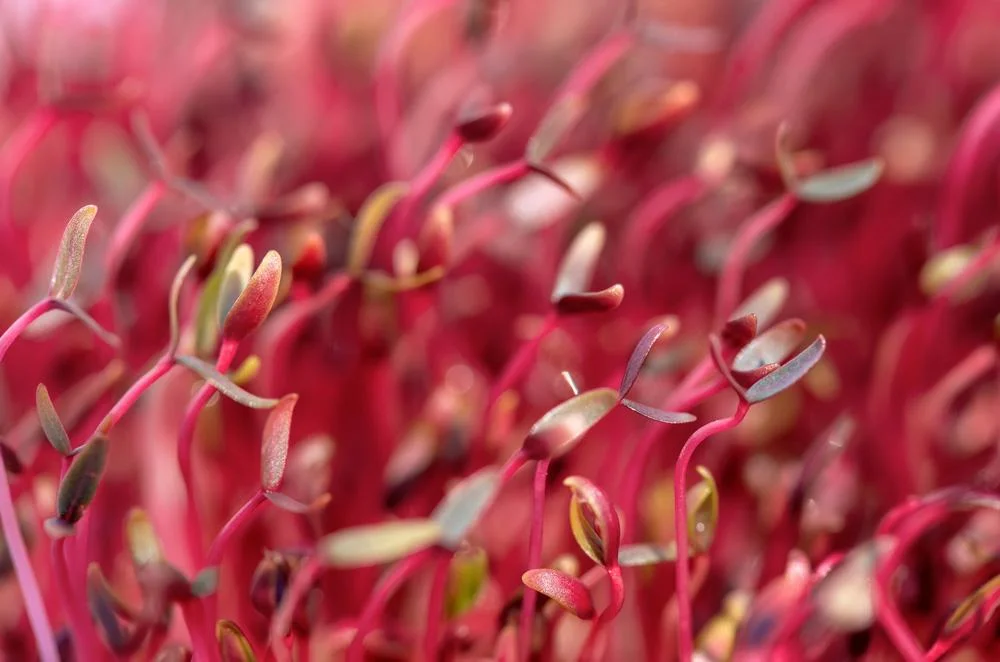Amaranth is commonly known as a pseudo-grain used by the Aztecs and is currently very popular in Mexican culture. However, other varieties of amaranth are cultivated for the purpose of using the leaves.
This pseudo-grain is actually very beneficial for health, either to replace other grains or as microgreens when consumed after being sprouted.
According to the USDA, amaranth microgreens contain few calories (23%) and are rich in vitamins K and C, manganese, folate, calcium, vitamin A, iron, magnesium, and potassium.
Garnet amaranth is the species with the highest concentration of nutrients, especially vitamins C, A, E, and K, and it closely resembles the red cabbage microgreens.
Vitamin K is essential to the health of the human body and has a variety of essential functions in the body. One of the most critical roles of vitamin K is its role in blood clotting. When a person is injured or suffers a wound, vitamin K helps produce the proteins needed to clot the blood and stop the bleeding. In this way, vitamin K speeds up wound recovery time and prevents excessive blood loss.
In addition, vitamin K is also essential for bone health. Vitamin K helps produce a protein called osteocalcin, which is necessary for new bone formation. Without enough vitamin K, the body may have difficulty producing enough osteocalcin, which can lead to decreased bone density and increase the risk of fractures.
Amaranth microgreens are one of the best sources of vitamin K available in the diet. One serving of amaranth contains 950% of the recommended daily value of vitamin K, which means it is an easy and efficient way to get enough vitamin K in the diet. For those who have difficulty getting enough vitamin K in their diet, amaranth microgreens are an excellent option for increasing their intake of this vital vitamin. In summary, including amaranth microgreens in the diet can improve bone health and blood clotting due to its high vitamin K content.
In addition, amaranth microgreens are rich in vitamin C, which helps protect and maintain the body’s cells, promoting healthy skin, blood vessels, cartilage, and bones and helping to heal wounds. They also contain manganese, which helps create and activate enzymes in the body, and folate or folic acid, an essential vitamin in creating new cells, especially for pregnant women.
Amaranth microgreens are rich in a variety of antioxidants and phytonutrients that make them an excellent choice for protecting the body against oxidative damage and promoting overall health. Antioxidants are compounds that help prevent cell damage caused by free radicals, which occur naturally in the body and can be caused by environmental factors such as pollution and radiation.
Carotenoids are a type of antioxidant found in amaranth microgreens. These compounds are responsible for the bright colors found in many fruits and vegetables and have been shown to have a variety of health benefits. Some studies have suggested that carotenoids may reduce the risk of chronic diseases such as heart disease and certain types of cancer.
Chlorophyll is another antioxidant found in amaranth microgreens. This compound is responsible for the dark green color of many plants. It has been shown to have anti-inflammatory and antioxidant properties that may help protect the body against oxidative damage.
In addition, amaranth microgreens contain other phytonutrients such as lutein, zeaxanthin, and beta-carotene, which also have antioxidant properties and may help prevent chronic diseases.
In summary, amaranth microgreens are a healthy and nutritious food that should be considered an essential addition to any balanced diet.
Disclaimer
The information provided in this article is for educational and informational purposes only and is not intended as medical advice. It is not a substitute for professional medical advice, diagnosis, or treatment. Always seek the advice of a qualified healthcare provider with any questions you may have regarding a medical condition. The author and publisher of this article are not responsible for any adverse effects or consequences resulting from the use of any suggestions, preparations, or procedures described in this article.
References
Booth, S. L. (1997). Skeletal functions of vitamin K-dependent proteins: not just for clotting anymore. Nutrition Reviews, 55(7), 282–284. https://doi.org/10.1111/j.1753-4887.1997.tb01619.x
Division of Plant Sciences. (n.d.). Amaranthus: Not Just a Weed (Michele Warmund). Missouri.edu. Retrieved March 10, 2023, from https://ipm.missouri.edu/MEG/2020/2/amaranthus/
Palace, V. P., Khaper, N., Qin, Q., & Singal, P. K. (1999). Antioxidant potentials of vitamin A and carotenoids and their relevance to heart disease. Free Radical Biology & Medicine, 26(5–6), 746–761. https://doi.org/10.1016/s0891-5849(98)00266-4
Rowles, J. L., 3rd, & Erdman, J. W., Jr. (2020). Carotenoids and their role in cancer prevention. Biochimica et Biophysica Acta. Molecular and Cell Biology of Lipids, 1865(11), 158613. https://doi.org/10.1016/j.bbalip.2020.158613
Uotila, L. (1990). The metabolic functions and mechanism of action of vitamin K. Scandinavian Journal of Clinical and Laboratory Investigation. Supplementum, 201, 109–117.
Xiao, Z., Lester, G. E., Luo, Y., & Wang, Q. (2012). Assessment of vitamin and carotenoid concentrations of emerging food products: edible microgreens. Journal of Agricultural and Food Chemistry, 60(31), 7644–7651. https://doi.org/10.1021/jf300459b






 Become a Reseller
Become a Reseller













